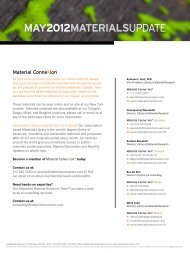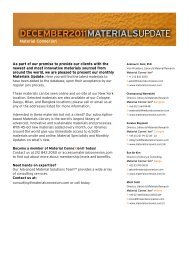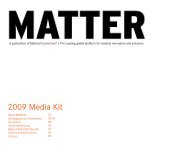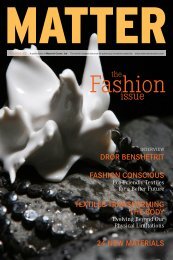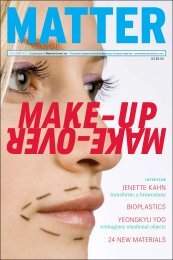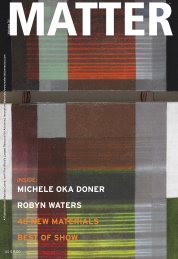48 new materials - Material ConneXion
48 new materials - Material ConneXion
48 new materials - Material ConneXion
You also want an ePaper? Increase the reach of your titles
YUMPU automatically turns print PDFs into web optimized ePapers that Google loves.
Images: © dbox for Cook + Fox Architects LLP<br />
hipsters can now be accidental environmentalists.<br />
Not only has the cotton apparel retailer embraced<br />
responsible manufacturing processes, it has also<br />
built a very successful (and damned sexy) business<br />
out of it. Originally conceived as a vertically-integrated,<br />
sweatshop-free T-shirt company,<br />
American Apparel has grown to become the nation’s<br />
largest T-shirt manufacturer. The company’s<br />
business ethic inevitably influenced their attitude<br />
regarding <strong>materials</strong>, with the 2003 launch of the<br />
Sustainable Edition ® . The line now encompasses<br />
16 different items for both children and adults<br />
in 100% USDA Certified Organic Cotton. Most of<br />
their most popular styles from other lines are<br />
available in organic cotton as well. The company<br />
aims for 80% overall use of organic cotton by<br />
2007. Of course, American Apparel addresses the<br />
issue of sustainability and style directly on their<br />
website: “By no means in integrating environmentally<br />
friendly fabric does this compromise American<br />
Apparel’s style and youth-driven fashion for<br />
environmental ethics.” Of course, as sustainability<br />
continues to mature, there should not be a need<br />
for this type of disclaimer.<br />
The <strong>new</strong> Bank of America Tower at 1 Bryant Park<br />
in New York City is an outstanding example of the<br />
harmonious combination of environmental concern<br />
and design integrity. As the first high-rise<br />
office tower to strive for a LEED platinum designation,<br />
the crystalline structure has redefined the<br />
standard of sustainable architecture. Glass, the<br />
primary visual component of the building, both<br />
enables the faceted, crystal-like appearance of<br />
the building and acts as an insulating skin. The<br />
extremely translucent, floor-to-ceiling windows<br />
are made of low-e insulating glass with advanced,<br />
double-wall technology. While offering fantastic<br />
views of the surrounding city (including the<br />
Empire State Building), the windows also dissipate<br />
the sun’s heat.<br />
1 Bryant Park’s Urban Garden Room<br />
Less visible, but equally important to the building’s<br />
environmental footprint, are the structural <strong>materials</strong><br />
and systems. The construction uses a minimum<br />
of 50% recycled material, with a minimum of 50%<br />
manufactured within 500 miles of the site. For<br />
the concrete foundation, 45% of the cement was<br />
replaced with blast furnace slag, a by-product of<br />
steel production. Approximately one ton of CO2 is<br />
saved per ton of replaced concrete. The building<br />
also integrates a gray-water system that captures<br />
and re-uses all rainwater and wastewater, saving<br />
10.3 million gallons of water annually. Finally, an<br />
onsite, 5.1-megawatt combined cycle co-generation<br />
plant will meet the building’s energy requirements<br />
cleanly and efficiently.<br />
If architecture could be considered a macro methodology<br />
for sustainability, furniture design is its micro<br />
counterpart. An overwhelmingly polluting industry,<br />
furniture manufacture offers many opportunities<br />
for improvement. One elegant solution is Imprint,<br />
a cellulose-based, molded chair by Lammhults. This<br />
chair mimics the curves of the Eames’ shell chair<br />
but is made with a much more eco-friendly material<br />
than the fiberglass that was previously used. This<br />
chair is produced from rectangular, flexible sheets<br />
of cellulose fibers that rigidized with heat and pressure<br />
in a mold. The resulting form takes advantage<br />
of the strength of wood and the versatility of<br />
plastic. To create rich, textural surface effects, the<br />
cellulose can be mixed with such natural fibers as<br />
spruce, coconut, and oak.<br />
With eco-friendly <strong>materials</strong> and manufacturing processes<br />
becoming the standard among <strong>new</strong> design<br />
projects, increasing levels of sustainability in your<br />
design practice are within reach. There is now the<br />
opportunity to integrate sustainability seamlessly<br />
within a design aesthetic, with no Birkenstocks or<br />
patchouli required. What are you doing to green<br />
your design?<br />
IN THE MATERIAL WORLD<br />
“Imprint Shell Chair” by Lammhults<br />
27




